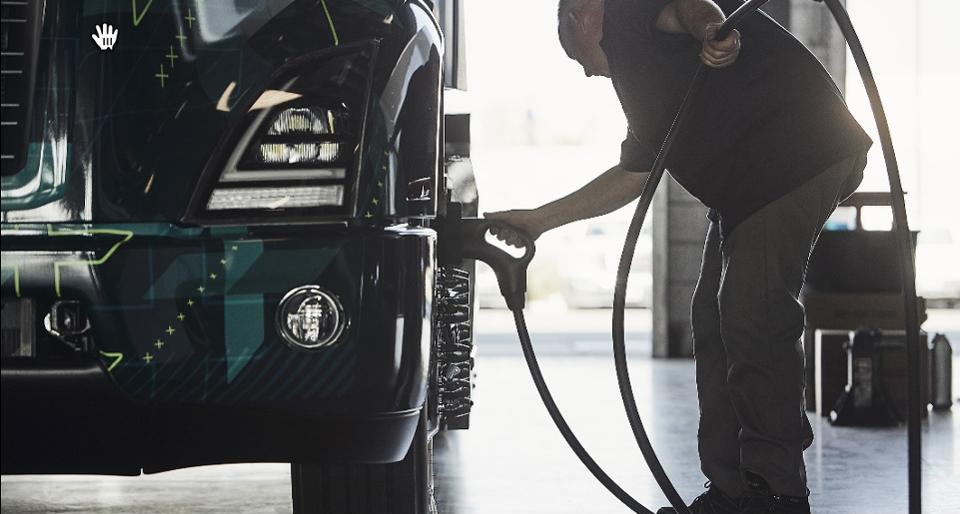Kategori : ELECTRICITY ENERGY NEWS, ENERGY AGENDA NEWS - Tarih : 14 June 2020
Volvo Trucks is now driven to roll out electrically-fueled heavy-duty trucks — the kind that makes short runs. It’s part of an effort by the state of California to help clean up air pollution and specifically in Los Angeles. Up first: about two dozen trucks with the accompanying charging stations.
Specifically, the California Air Resources Board is investing $45 million. The money will be used by Volvo Trucks and 14 others to advance electric transportation and to promote zero-emissions  technologies. Those private businesses are contributing the same amount of money, all to accommodate what they believe will be strong demand — one motivated by cheaper operational and maintenance costs along with mandatory rules to reduce harmful air emissions.
technologies. Those private businesses are contributing the same amount of money, all to accommodate what they believe will be strong demand — one motivated by cheaper operational and maintenance costs along with mandatory rules to reduce harmful air emissions.
“This project aligns with our core values as a company, which are about safety and care for the environment,” says Keith Brandis, vice president of partnerships and strategic solutions for Volvo Group, in a talk with this writer. “It is a business and as such, it has to be reasonable: anyone can build a prototype in the garage. But we will not deliver the trucks until we have the complete system in place, which includes the technicians and electrical infrastructures.”
Volvo Trucks is now driven to roll out electrically-fueled heavy-duty trucks — the kind that makes short runs. It’s part of an effort by the state of California to help clean up air pollution and specifically in Los Angeles. Up first: about two dozen trucks with the accompanying charging stations.
Specifically, the California Air Resources Board is investing $45 million. The money will be used by Volvo Trucks and 14 others to advance electric transportation and to promote zero-emissions technologies. Those private businesses are contributing the same amount of money, all to accommodate what they believe will be strong demand — one motivated by cheaper operational and maintenance costs along with mandatory rules to reduce harmful air emissions.
“This project aligns with our core values as a company, which are about safety and care for the environment,” says Keith Brandis, vice president of partnerships and strategic solutions for Volvo Group, in a talk with this writer. “It is a business and as such, it has to be reasonable: anyone can build a prototype in the garage. But we will not deliver the trucks until we have the complete system in place, which includes the technicians and electrical infrastructures.”
The trend can’t happen quickly enough. The transportation and electricity sectors account for more than half of all greenhouse gas emissions in the United States. And in 2016, CO2 concentration levels had surpassed the 400 parts per million threshold, which is the red line where climate scientists say that the ecological impacts of warming are irreversible. The National Oceanic and Atmospheric Administration says that they are at 416 parts per million as of May 2020.
“There are the same parallels as solar, which is a lot of interaction between the government and the private sector to drive this forward and gain scale,” says Bob Stojanovic, director of electric vehicle infrastructure North America at ABB, which is creating the software programs and the hardware to build out the needed charging infrastructure. “Once this is achieved, then those incentives are not needed. The cost will come down because of the scale. And it is self-perpetuating.”
The ABB executive told this reporter that there are now four sites with a dozen chargers each, all in the Los Angeles area. The goal is to grow, which is contingent not just on the demand for those electric trucks but also on the supply chains. For example, Edison International EIX’s Southern California Edison is developing a grid impact assessment and the wires needed to provide reliable and cost-effective power to commercial fleet operators. And Volvo has to work with community colleges to train the mechanics to service those trucks.
So, it is not as easy as just building the trucks and creating the charging stations. That said, Stojanovic has an upbeat view of market potential: the electric vehicle segment, generally, is growing at 35% a year, he says, which has the potential to double once the technology is proven and is scalable. Wood MacKenzie says that electric batteries will hit an inflection point in 2027 while Bloomberg New Energy Finance points out that such prices have fallen by 87% since 2010.
To be sure, Volvo says that it will continue to sell trucks that run on diesel fuel and that it expects this market to remain strong; the infrastructure to operate and maintain it is viable. There are also natural gas-fueled trucks, which need to have their oil changed more often than diesel: Liquefied natural gas is best used with heavy trucks while compressed natural gas is used to power





